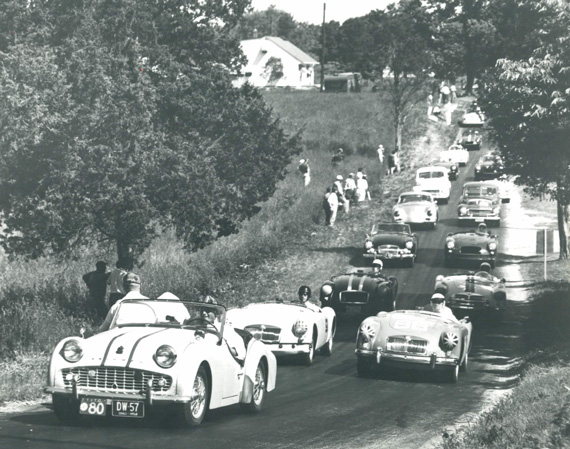
David Weisenberger is at the wheel of the TR 3 pace car in the 1958 event. Behind, the F production field, made up of MG-As and Porsches with a few Volvos 544s. This is the long back straight where speeds are kept down by frost heaves in the macadam. Collection of Betty Henn. Click to enlarge
The Put-in-Bay Races, 1952-1963
By Carl Goodwin
272 pages, B&W photos, softcover
$35
P ISBN 978-0-7864-7930-6
E ISBN 978-1-4766-1459-5
McFarland, 800-253-2187
Order from; www.mcfarlandpub.com
A Review by Pete Vack
Images from the book: Click to enlarge
As F. Scott Fitzgerald realized, America restlessly moves on, reaching for what lies ahead yet longing for what lies behind. But four-time Carl Benz Award-winning-author/historian Carl Goodwin is no misty-eyed nostalgia buff; he assiduously chronicles the past from the point of view of others. He goes far beyond the call of sweet memory to create jewel-like masterpieces such as They Started in MGs and his second book, The Put-in-Bay Road Races 1952-1963 that will shine long after the nostalgia has faded.

The town of Put-in-Bay is located on South Bass Island, about 280 miles from Chicago, 90 miles from Detroit and 80 miles from Cleveland.
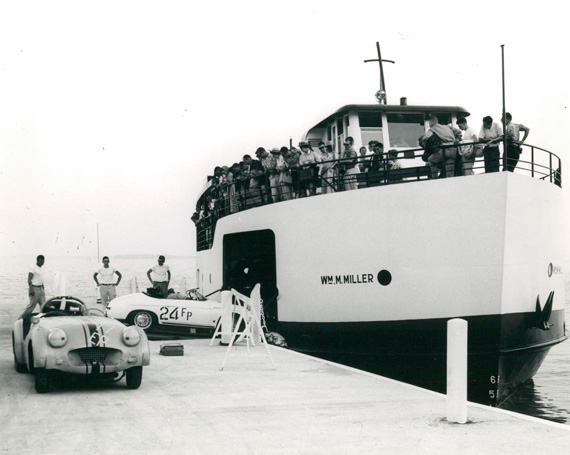
The Porsche Speedster of Roy Orr and Ernest Davis’ TR-2 are loaded aboard Miller’s Ferry at Catawba before the 1959 race. Credit Rollin La France. Click to enlarge
Being thusly rooted only ads to Goodwin’s passion and desire to tell the complete story. Put-in-Bay was a Camelot-like sports car event that for over 10 years offered real road racing on a historic, charming island reached only by boat and Ford Tri-motor, an event that saw the latest Alfas, MGs, Bandinis, Siatas, and Porsches race year after year with a perfect safety record.
And yet a race so obscure few knew it existed.
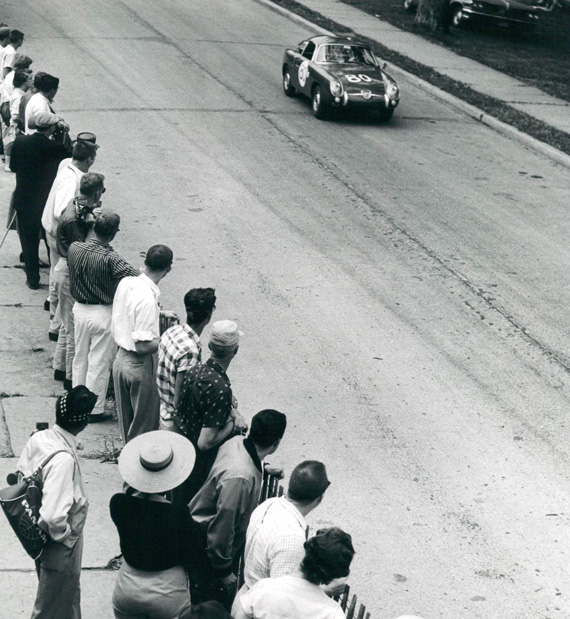
Not the Mille Miglia: Put-in-Bay, 1959. Bob Stein in his Abarth750 GT Zagato charges down the main street to the delight of the spectators not used to seeing such diminutive automobiles. Bob was first in class, followed by the Abarth of Dave Stone. Credit Rollin La France
For twenty seven years, Goodwin gathered up rare photos, interviewing the participants while they were still on the green side of the grass, scoured the papers and magazines for references, found all the results and entries, and recorded every anecdote from the local drunk who fell asleep on Cemetery curve to the fastest lap made with a modified Porsche Spyder. And did so with the skill, forbearance, dedication, and attention to detail of a trained professional historian.
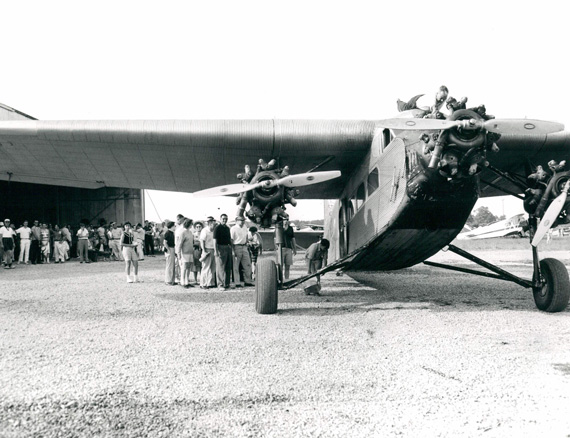
Only the brave made the lake crossing by Ford Tri-Motor. Unconcerned passengers wait while routine maintenance is performed; something to do with the oil dripping from an engine. Credit Rollin La France. Click to enlarge
From 1985 to 2013, Goodwin talked to the people that were there, over 100 of them; he found them by phone and email and letters and at home; he found that they are not hallowed weekend warriors, but shop owners and car dealers and fathers and mothers that came home from the war and took advantage of all the benefits offered by their country to start businesses, buy homes and get an education. He found that the guys who owned that Porsche Spyder and drove like the wind though the tiny island village were really guy just like you and I, perhaps a generation removed, but real people. For real people is what Carl, and this book is about; he is the perfect writer for a wonderful book about an idyllic event.
“There was nothing like that race. It was like a dream of anybody who would just like to get in his car and go fast. It was just going to some little town and driving your heart out” –Lorrain Holder, Porsche Spyder
We are all familiar with the early races at Bridgehampton, Watkins Glen, Road America, Torrey Pines and Pebble Beach, all of which have excellent books which duly record these road races. But until Goodwin began writing about Put in Bay, the event was virtually unheard of; what we knew was only bits and pieces; a ferry, a few Alfas, and as Michael T. Lynch (who was also there) recalled, a fabulous Ferrari 410 America which once served as a pace car. The Ferrari served as a pace car as the event was limited to under 2 liters, much like Bryfan Tyddyn.
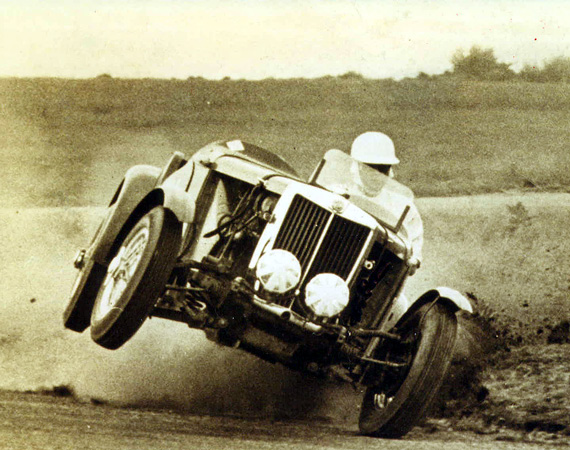
Classic Joe Brown photo of driver Bill Randle nearly rolling his MGTD near Airport Corner in 1953. There were no deaths, no serious mishaps in over ten years of road racing at Put-in-Bay. Credit Joe Brown. Click to enlarge
This bit of wisdom was due to organizers John Birchfield and Norman Bradley, who laid out the 3.1 mile course. The 2 liter limit would contribute immensely to the safety of the races, but also keep the event in perpetual obscurity; no big Ferraris, Jags, Allards, no Kimberly, Hill, Shelby. No names, no gains. But PIB had another claim to fame: the last event was run in 1963, making it the very last American race to be held on public roads (the prison-walled events Long Beach etc being odd exceptions).
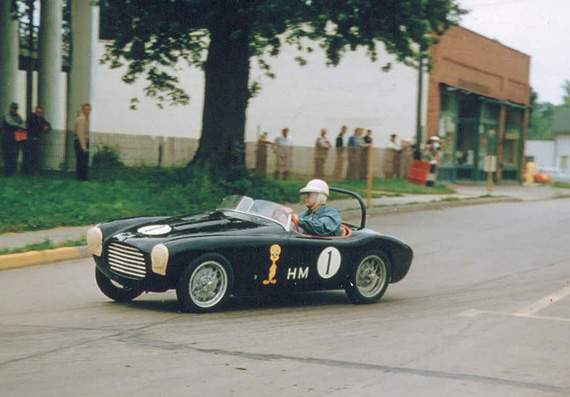
Chuck Stoddard, who is well known for his racing Alfas, is in the 750 cc Siata Spider with the Tweety Bird cartoon on the side, takes the last corner into town in 1957. This color photo appears as B&W in the actual book. Credit Joe Brown. Click to enlarge
Goodwin begins his book with a delightful description of what he called the Summer Paradise in 1951, and follows this with an overall view of the events as they transpired between 1952 and 1963. Then he takes it year by year, each chapter recounting the winners, losers, close calls, unusual cars, and more often hilarious anecdotes. There is a bit of overlap; some of the anecdotes are repeated and one wonders, “didn’t I read this before?” Fortunately they are worth repeating.
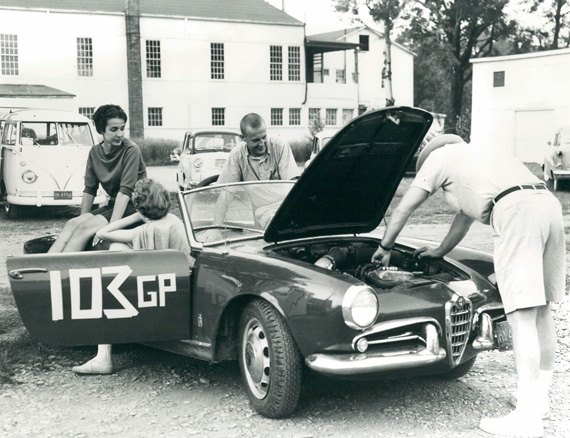
The #103 black Alfa Giulietta gets a once-over by the crew while the driver’s guests discuss whether it would be best to use 1.10 or 1.25 main jets in the carbs. Credit Rollin La France. Click to enlarge
The photos, some presented here from the book, are another treasure. We’d guess that aside from a few perhaps appearing in Carl’s articles in Vintage Motorsport or Automobile, most of the photos in the book have not published before and are, for the most part, done by professional photographers of the time. And they are outstanding. Our only wish is that they had been printed on glossy paper. But if so, the price, a very reasonable $35.00, would not have been possible. For that money, McFarland has put together an outstanding book, complete with a very good bibliography and index.
A final thought; Carl’s book(s) add to the body of knowledge of the foreign car revolution that took place in the United States between 1945 and 1975, a segment of history we would like to see be taken more seriously. For as Miles C. Collier recently pointed out in the preface to Lancia and De Virgilio: At The Center, “The automobile is quite simply the most important technological object of the 20th century.” Many of the people who took part in the Put-in-Bay races were an important part of the fledgling imported car industry which changed forever the way Detroit builds and sells cars; early SCCA amateur racing was a prime catalyst of that change and Goodwin has captured the enthusiasm and energy of that generation.
Thank you for giving this book and the event the attention they deserve. Carl is not only a true enthusiast, he is one of the genuine scholars in his area of interest. I can’t wait to get my copy.
Carl is a frequent guest and presenter at the annual Put-in-Bay Road Races Reunion which began in 2009 and now includes a revival of the past events — real wheel to wheel racing on the island once again. No longer safe to race on the island’s roads (hell, it wasn’t safe back in the day, but somehow they pulled it off with no serious injury to driver or spectator) vintage sports car races are now run on the island’s airport. For more information see http://www.pibroadrace.com.
A great book by a great scholar about a great event. Thank you Carl for putting it all in perspective.
The Put-in-Bay Road Race Reunion, as founded by Jack Woehrle and organized by Manley Ford, Bob & Linda Williams, Rich Hahn, etc. is a terrific way to remember the racing there. It is usually in late August. Take the ferry boat over to the island and have a great time.
Maybe I’ll try to bring my SIATA 300 BC Sport Spyder # 446 over there next year. It raced back there “in-the-day”
Bill L.
As one of the very first Put in Bay participants, I learned much I either never knew, or forgot, about those early years, due to Carl’s accumulation of facts, photos and trivia with heart and nostalgia.
You will find me in both of his books.
I revisited the Memories and now the island and renewed acquaintances in his 2 books and in person this year.
Well researched and documented with the best indexes I can recall, you will love visiting the melancholy of our youth along with him.
To Sally Carroll – thanks for your thoughts and your insights into the Golden Age of sports car racing.
To Bill Lightfoot — it sure would be nice to see an H-Modified Siata at Put-in-Bay one more time. If you go, you will enjoy the cars, the people and the place.
You sure that’s a TD ? Looks like TC wheels to me. No TD’s came stock with wire wheels.
To William F. Bayley — The “Up On Two Wheels” Bill Randle car is definitely a TD. Racer Hank Becker once described it in detail for me. He said “John Moncur was a Brit who worked for Jaguar Cleveland. Bill had John set up an MG TD for him. This was going to be a state-of-the-art, stand-back racing car. God knows what it cost.” Also, TD wire wheel conversions were common. You could get them from Dunlop or the up-market kind from Borrani.
Amazing, a picture of the Speedster I never knew existed. That car also got me to work and home every day. Find memories, Roy Orr